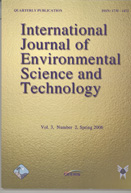
|
International Journal of Environment Science and Technology
Center for Environment and Energy Research and Studies (CEERS)
ISSN: 1735-1472
EISSN: 1735-1472
Vol. 13, No. 2, 2016, pp. 561-570
|
 Bioline Code: st16051
Bioline Code: st16051
Full paper language: English
Document type: Research Article
Document available free of charge
|
|
|
International Journal of Environment Science and Technology, Vol. 13, No. 2, 2016, pp. 561-570
| en |
Adsorptive removal of reactive dyes from aqueous solution using activated carbon synthesized from waste biomass materials
Thitame, P. V. & Shukla, S. R.
Abstract
High-activity mesoporous carbons were prepared
from wild almond shells and coir pith by phosphoric
acid activation and applied for adsorption of the dyes, C.I.
Reactive Red 2 and C.I. Reactive Yellow 145A. The BET
surface areas of these activated carbons were found to be
1133.25 and 1210.58 m2/g, respectively. The equilibrium
data were best described by the Langmuir isotherm in all
the cases. The maximum dye adsorption capacity shown by
the activated carbon produced from coir pith was
2022.9 mg/g for C.I. Reactive Red 2 and 1694.3 mg/g for
C.I. Reactive Yellow 145A at 60 °C with initial concentration
of 1000 mg/L. Pseudo-second-order kinetic model
gave a good fit, with the intraparticle diffusion being one of
the essential rate-controlling steps. Thermodynamic analysis
revealed that the adsorption of both the dyes on activated
carbons was spontaneous and endothermic in nature.
The t test analysis showed that the difference between
adsorption capacities of the produced activated carbons
was not significant at 95 % confidence level at all the
temperatures studied.
Keywords
Adsorption kinetics; Coir pith; Phosphoric acid activation; Wastewater; Wild almond shell
|
| |
© Copyright 2016 - International Journal of Environment Science and Technology
Alternative site location: http://www.ijest.org
|
|
